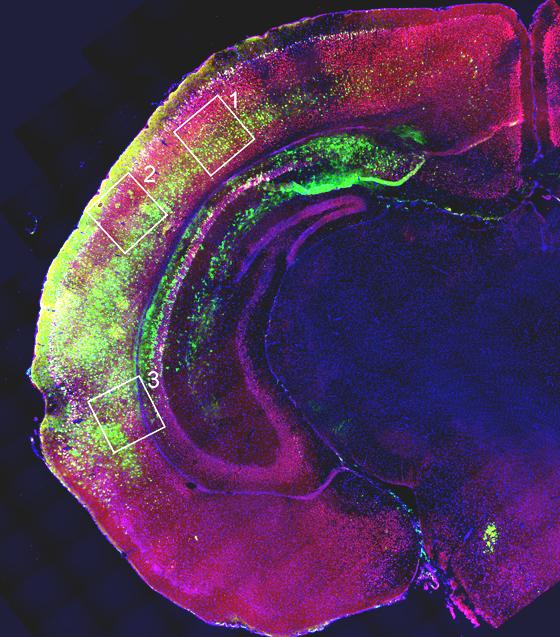Double effort against Rett's syndrome

The rat's brain areas stimulated in the study. Credit: SISSA
Imagine that a colleague of yours has fallen ill and will be absent for a while from the office. What do you do? Do you go on working at your usual pace and by doing so risk a huge backlog of work that will affect the performance of the whole office, or do you roll up your sleeves and get down to it (perhaps also after your boss has motivated you by promising some benefit) by doubling your efforts and doing your absent colleague's work as well as your own?
Something similar occurs with genes when their homologues are missing, a condition doctors call haploinsufficiency. When this abnormality manifests, especially when it concerns genes that have an important function in the central nervous system, it may lead to very serious diseases, such as Rett's syndrome that causes severe progressive mental retardation related to the FOXG1 gene.
A group of researchers at the International School for Advanced Studies (SISSA) in Trieste, led by Antonello Mallamaci, has decided to adopt the “motivational” boss strategy by stimulating the surviving FOXG1 gene to work more to compensate for the absence of the missing gene.
“By using viral vectors to insert into neurons RNA fragments targeting the gene's regulatory sequences, we “gently” stimulated the gene to do more work, in particular nearly double”, explains Mallamaci. “Note that we don't want the gene to do more than that. If it worked, say, three times as much, it could cause even worse damage”. In fact, it is known that when three copies of the FOXG1 exist (one more than normal), we have West's syndrome, which is perhaps even worse as it causes a severe form of epilepsy. “It's therefore vital that the gene we stimulate does no more than about double the normal amount of work”.
The method adopted by the Trieste group is a “cunning” solution to the treatment problems posed by these diseases. “Stimulating the normal gene allows us to preserve its natural endogenous regulation”, explains Mallamaci. Genes in fact are not expressed everywhere and at the same intensity: to the contrary, in many body tissues they are silenced, in others their activity is time-modulated with great precision. If their regulation were to be disrupted, it is easy to imagine the chaos that this would generate. “Going back to the office worker's metaphor, it's like having an inexperienced intern do the absent worker's job: at best he won't do anything, at worst he'll mess things up. Instead, asking an experienced colleague, who's familiar with the office's processes and rhythms, to work harder, offers greater guarantees”.
Multiple tests
The team ran several tests. First, in vitro, the scientists checked whether stimulation through promoter RNA was able to amplify gene activity only where it was needed. “FOXG1 is only active in the anterior brain and we absolutely don't want it to act elsewhere in the nervous system or the body”, explains Mallamaci. “The tests gave positive results: after stimulation, the gene continued to be expressed only in cells where it had previously been active and remained silent in tissues where it normally doesn't work. Very importantly, the activity observed increased by a factor not far from 2, i.e. that “double” expression that we were trying to achieve”.
The second test, also in vitro, demonstrated that the gene's endogenous regulatory mechanisms related to the electrical activity of the neurons expressing it are not altered by stimulation with RNA: “we saw a rise in the gene's activity, but the shape of the time-activity curve was basically unchanged, a clear indication that regulation remains the same”, explains Cristina Fimiani, PhD student in Functional and Structural Genomics at SISSA and co-first author of the study.
The third step was to see whether the stimulation also worked in vivo. “The test was done on healthy mice and we found that the stimulation was even more effective in vivo than in vitro,” Mallamaci concludes.
“We're still at the beginning of a very long clinical process that might one day lead to treatment”, he adds. “The results, though, are very clear and definitely encourage us to continue this line of research. The next steps will be in vivo tests on animal models affected by the disease”.
What makes these therapies so interesting for the future? “Rett's disease is rare and affects only a small number of patients, so it doesn't attract the attention and investments of major pharmaceutical companies”, concludes the scientist. “But, taken together, haploinsufficiencies affect very many people. The methodology we present in this study is therefore a test for a general method capable of fighting the large number of haploinsufficencies affecting the nervous system, and once developed it could be easily adapted to different genes”.
Media Contact
All latest news from the category: Health and Medicine
This subject area encompasses research and studies in the field of human medicine.
Among the wide-ranging list of topics covered here are anesthesiology, anatomy, surgery, human genetics, hygiene and environmental medicine, internal medicine, neurology, pharmacology, physiology, urology and dental medicine.
Newest articles

NASA: Mystery of life’s handedness deepens
The mystery of why life uses molecules with specific orientations has deepened with a NASA-funded discovery that RNA — a key molecule thought to have potentially held the instructions for…

What are the effects of historic lithium mining on water quality?
Study reveals low levels of common contaminants but high levels of other elements in waters associated with an abandoned lithium mine. Lithium ore and mining waste from a historic lithium…

Quantum-inspired design boosts efficiency of heat-to-electricity conversion
Rice engineers take unconventional route to improving thermophotovoltaic systems. Researchers at Rice University have found a new way to improve a key element of thermophotovoltaic (TPV) systems, which convert heat…



